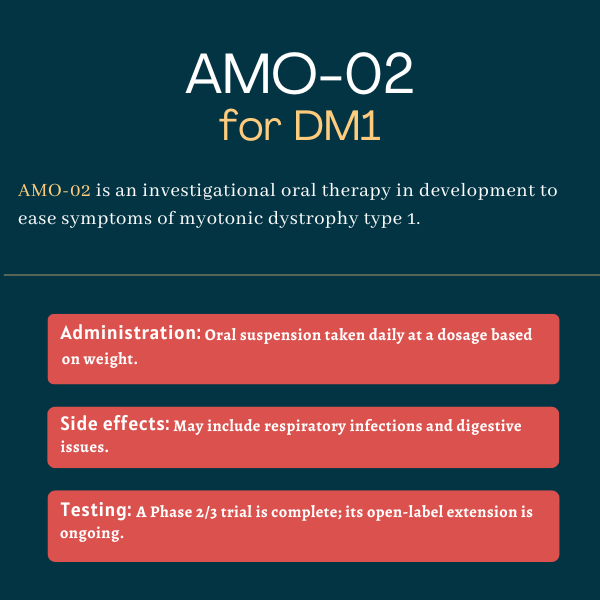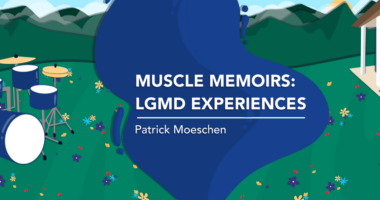AMO-02 for myotonic dystrophy type 1
Last updated Oct. 13, 2025, by Marisa Wexler, MS

What is AMO-02 for myotonic dystrophy?
AMO-02 (tideglusib), an experimental oral treatment from AMO Pharma, is being developed to slow disease progression in myotonic dystrophy type 1 (DM1).
DM1 is a genetic disorder marked by muscle weakness, wasting, and myotonia (an inability for muscles to relax after contracting). AMO-02 is designed to inhibit the activity of a muscle enzyme called glycogen synthase kinase 3 beta, which normally helps regulate energy storage in muscle cells but is overactive in DM1 patients.
Preclinical studies in a mouse model of DM1 suggested that blocking this enzyme may reduce muscle weakness and myotonia. AMO-02 also targets the disease-causing accumulation of certain abnormally long RNA molecules that clump inside cells and impair their normal functioning.
AMO-02 is also in clinical development as a potential treatment for arrhythmogenic right ventricular cardiomyopathy, a form of heart disease.
Therapy snapshot
| Treatment name: | AMO-02 |
| Administration: | Oral suspension |
| Clinical testing: | Open-label extension of Phase 2/3 trial ongoing |
How will AMO-02 be administered?
AMO-02 is available as an oral suspension. In a Phase 2/3 clinical trial in congenital DM1, the therapy was administered daily at weight-adjusted doses ranging from 400 to 1,000 mg per day.

AMO-02 in clinical trials
A Phase 2/3 clinical trial called REACH-CDM (NCT03692312) tested AMO-02 against a placebo in 56 children and adolescents with congenital DM1 ages 6 to 16.
- REACH-CDM aimed to show that patients given AMO-02 would have significantly better scores on the Clinician-Completed Congenital DM1 Rating Scale (CDM1-RS), a clinician-rated measure of DM1 disease severity. The study failed to meet this goal; no difference in CDM1-RS scores was seen between AMO-02 and the placebo after 20 weeks. Still, the findings showed a clinically and statistically significant improvement in a measure of cognition, a significant decrease in levels of a biomarker of muscle damage, and a trend toward improvement in a tool of walking ability.
- An extension study called REACH CDM-X (NCT05004129) is ongoing in patients who completed the parent study, as well as previously untreated congenital or childhood-onset DM1 patients, up to age 45. All participants are being treated with AMO-02 and monitored for long-term outcomes. Recent data at about four years of follow-up showed that the average hospitalization rate per patient was lower than once every six years. Additionally, participants aged 10 years and older showed little or no decline in walking function over one year of treatment. AMO-02 therapy was generally well tolerated.
AMO has announced plans for a Phase 3 trial to evaluate the safety and efficacy of AMO-02 in adult-onset DM1. The trial is expected to have a similar design to REACH-CDM.
AMO-02 side effects
The most common adverse events seen in patients on long-term AMO-02 treatment during the REACH CDM-X trial were respiratory infections and digestive events.
Muscular Dystrophy News Today is strictly a news and information website about the disease. It does not provide medical advice, diagnosis, or treatment. This content is not intended to be a substitute for professional medical advice, diagnosis, or treatment. Always seek the advice of your physician or other qualified health provider with any questions you may have regarding a medical condition. Never disregard professional medical advice or delay in seeking it because of something you have read on this website.
Recent Posts
- Hope takes center stage as musical honors healthcare professionals
- 3-drug cocktail boosts DMD gene therapy effectiveness in mice
- The holiday season makes me regret not making my kids do chores
- Rainy days, Mondays, and FSHD make feeling grateful a challenge
- Myotonic dystrophy drug SRP-1003 trial advances to higher doses






